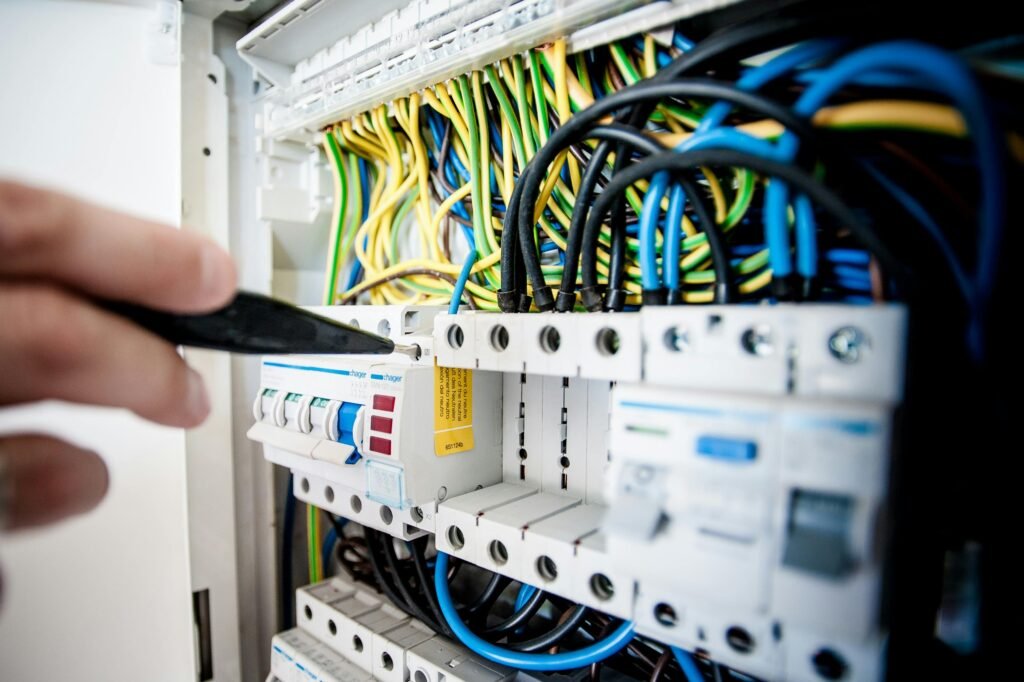Imagine snuggling up on a cold winter evening, sipping a warm cup of cocoa, and enjoying the comforting crackle of a cozy fireplace. To ensure this delightful experience becomes a reality throughout the chilly months, it’s crucial to keep your fireplace heater in top shape. From checking the flue to cleaning the chimney, our comprehensive Fireplace Heater Maintenance 101 checklist will guide you through all the essential steps to keep your home warm and your fireplace functioning efficiently.

This image is property of images.pexels.com.
Inspect the Fireplace
Check for any visible cracks or damages
To ensure the safety and efficiency of your fireplace heater, it’s crucial to start by inspecting the fireplace itself. Check for any visible cracks or damages on the walls, floor, and hearth. These can indicate structural issues or potential hazards that need to be addressed before using the fireplace. If you notice any cracks or damages, it’s best to consult a professional for further evaluation and repairs.
Ensure that the fireplace doors are functioning properly
Next, take a moment to check the functionality of your fireplace doors. Open and close them to ensure they are working smoothly. If you have a glass door, inspect it for any cracks or chips that may compromise its integrity. Properly functioning fireplace doors not only enhance the aesthetics of your fireplace but also help control the airflow and keep the warm air from escaping.
Clean out any debris or ashes from previous use
Before starting a new fire, it’s essential to clean out any debris or ashes left behind from previous use. Use a fireplace shovel or brush to carefully remove the remains and dispose of them properly. Leaving ashes can restrict airflow and hinder the efficiency of your fireplace. Additionally, build-up of debris can pose a fire hazard, so make sure to remove it thoroughly.
Inspect the chimney for any signs of blockage or damage
Lastly, inspect your chimney for any signs of blockage or damage. Look for obstructions such as bird nests or debris that may be blocking the flue. If you notice any cracks, loose bricks, or crumbling mortar, it’s crucial to address these issues promptly as they can lead to chimney fires or gas leaks. Consider hiring a professional chimney sweep to conduct a thorough inspection and cleaning for your peace of mind.
Clean the Fireplace
Remove any leftover ash and soot
To maintain the cleanliness and efficiency of your fireplace heater, it’s important to remove any leftover ash and soot. Use a fireplace shovel or brush to carefully scoop out the ashes and dispose of them in a metal container. Avoid using a regular vacuum cleaner as it may not be designed to handle fine ash particles and could damage the machine.
Use a vacuum or brush to clean the inside walls and floor of the fireplace
Once you’ve cleared out the ashes, grab a vacuum cleaner or a fireplace brush to clean the inside walls and floor of the fireplace. Gently brush away any loose debris or soot, starting from the top and working your way down. Be thorough but cautious to avoid damaging the fireplace’s surface. For hard-to-reach areas, consider using a vacuum cleaner attachment or a long-handled brush.
Wipe down the fireplace doors and handles with a damp cloth
While cleaning the inside of the fireplace, don’t forget to wipe down the fireplace doors and handles. Use a damp cloth to remove any dust, ash residue, or fingerprints. This simple step not only keeps your fireplace looking clean and well-maintained but also helps prevent the build-up of grime that could affect the smooth operation of the doors.
Clean the chimney flue and remove any buildup
Cleaning the chimney flue is an essential part of fireplace heater maintenance. Use a chimney brush to carefully remove any creosote or other build-up from the flue walls. Creosote is a highly flammable substance that can accumulate over time and pose a serious fire hazard. If you’re unsure about how to clean the chimney flue yourself, it’s best to hire a professional chimney sweep to ensure it’s done safely and thoroughly.
Check the Chimney
Inspect and clean the chimney cap
The chimney cap plays a crucial role in keeping debris, animals, and rainwater out of your chimney. Regularly inspect the cap for any damage or signs of wear and tear. Clean it to remove any dirt, leaves, or twigs that may have accumulated. A well-maintained chimney cap prevents blockages and helps maintain the efficiency and safety of your fireplace heater.
Ensure that the damper is opening and closing properly
The damper controls the airflow in your chimney and fireplace. Check if it’s opening and closing smoothly and without any obstructions. A properly functioning damper helps regulate the amount of air entering the fireplace, allowing for better control of the fire and heat. If you encounter any issues with the damper, consult a professional to ensure proper repairs and adjustments.
Look for any signs of animal nests or blockage in the chimney
Your chimney can attract small animals seeking shelter, especially during colder months. Look for signs of animal nests or blockages, such as twigs, leaves, or droppings. These can obstruct the airflow and prevent proper ventilation of smoke and gases from the fireplace. If you discover any blockages or animal activity, it’s recommended to call a professional chimney sweep to remove them safely.
Consider hiring a professional chimney sweep for a thorough cleaning
While regular maintenance tasks can be performed by homeowners, it’s wise to invest in a professional chimney sweep for a thorough cleaning at least once a year. A professional will have the expertise and specialized equipment to remove stubborn build-up, inspect and repair any chimney damage, and ensure that your fireplace heater operates efficiently and safely.
Test the Gas Fireplace
Check the gas supply and ensure it is connected
If you have a gas fireplace, it’s crucial to check the gas supply and ensure it is properly connected. Inspect the gas line for any leaks or damages. If you detect the smell of gas or suspect a leak, immediately turn off the gas supply and contact a professional technician for assistance. Gas-related issues should always be handled by trained professionals to avoid any potential dangers.
Test the ignition switch and pilot light
To ensure proper functioning of your gas fireplace, test the ignition switch and pilot light. Follow the manufacturer’s instructions on how to safely turn on the fireplace and ignite the pilot light. If the pilot light fails to ignite or stay lit, it could indicate a problem with the gas supply or the ignition system. In such cases, it’s best to consult a professional for proper diagnosis and repairs.
Inspect the burner and clean any debris
A clean burner is key to maintaining the efficiency and performance of your gas fireplace. Once the pilot light is ignited, inspect the burner for any debris or blockages. Use a soft brush or compressed air to remove any dirt, dust, or spider webs that may have accumulated on the burner. Clearing the burner ensures a clean and consistent flame, providing optimal heat output.
Check the gas valve for leaks or malfunctions
The gas valve controls the flow of gas to your fireplace. Inspect the valve for any leaks or malfunctions. Apply a mixture of soapy water to the connection points and look for any bubbles that indicate gas leakage. If you notice any leaks or suspect a malfunction, turn off the gas supply immediately and contact a professional technician to assess and repair the issue.

This image is property of images.pexels.com.
Maintain the Firewood
Store firewood in a dry place to prevent moisture
Properly seasoned firewood is essential for efficient and clean burning in your fireplace. Store firewood in a dry and well-ventilated area. Avoid stacking wood directly on the ground to prevent moisture absorption. Use a firewood rack or pallets to elevate the wood and allow for air circulation, which helps dry the wood and prevents the growth of mold or mildew that can affect your indoor air quality.
Keep firewood at least 30 feet away from the fireplace
To minimize the risk of fire hazards, it’s important to maintain a safe distance between your firewood stack and the fireplace. Keep firewood at least 30 feet away from the fireplace or any other heat source. This precaution helps prevent accidental ignition of nearby wood and reduces the likelihood of sparks or ember landing on the firewood stack.
Avoid burning treated or painted wood
When choosing firewood, it’s important to select untreated and unpainted wood. Treated or painted wood can release toxic chemicals when burned, posing health risks and potentially damaging your fireplace or chimney. Stick to using seasoned hardwoods, such as oak or maple, for a cleaner and more efficient burning experience.
Use a moisture meter to check the moisture content of the firewood
To ensure that your firewood is properly seasoned, use a moisture meter to check its moisture content. Well-seasoned firewood typically has a moisture content of 20% or less. Moisture levels above this can lead to inefficient burning, excessive smoke, and increased creosote buildup in your chimney. By periodically checking the moisture content of your firewood, you can optimize your fireplace’s performance and minimize potential issues.
Check the Electric Fireplace
Inspect the power cord for any damages
If you have an electric fireplace, it’s important to inspect the power cord for any damages or frayed wires. Damaged cords can present a safety hazard and should be replaced immediately. Avoid using extension cords with your electric fireplace and plug it directly into a grounded outlet to ensure the safe operation of the appliance.
Clean the heating element and fan
Regular cleaning of the heating element and fan is crucial for maintaining the efficiency and performance of your electric fireplace. Follow the manufacturer’s instructions on how to safely access and clean these components. Use a soft brush or cloth to remove any dust or debris that may have accumulated. Properly cleaning the heating element and fan prevents overheating and ensures even heat distribution.
Test the thermostat and timer functions
To ensure your electric fireplace operates according to your desired settings, test the thermostat and timer functions. Adjust the thermostat to different temperatures and verify that the fireplace responds accordingly. Set the timer to turn the fireplace on and off at specific intervals to check its functionality. If you encounter any issues or inconsistencies, consult the manufacturer’s instructions or contact customer support for assistance.
Ensure that the smoke and carbon monoxide detectors are functioning properly
Safety should always be a top priority when using any fireplace heater. Ensure that your smoke and carbon monoxide detectors are installed in the appropriate locations near your electric fireplace. Test these detectors regularly to ensure they are functioning properly and replace the batteries as needed. Smoke and carbon monoxide detectors provide early detection of potential hazards, giving you peace of mind while enjoying the warmth of your electric fireplace.

This image is property of images.pexels.com.
Service the Blower
Clean the blower fans and blades
The blower in your fireplace heater plays a vital role in distributing warm air throughout your home. Regular cleaning of the blower fans and blades ensures optimal airflow and performance. Shut off the fireplace, unplug it from the power source, and carefully remove the blower assembly. Use a soft brush or cloth to gently remove dust and debris from the fans and blades. Once clean, reassemble the blower and secure it back into place.
Check for any loose or damaged parts
While servicing the blower, take the opportunity to inspect for any loose or damaged parts. Check the screws, bolts, and connections to ensure they are secure and tight. Look for any signs of wear or damage on the blower housing, motor, or wiring. Loose or damaged parts can affect the blower’s performance or present safety hazards, so addressing them promptly is crucial.
Lubricate the motor and bearings if necessary
Proper lubrication is essential to maintain the smooth operation of the blower motor and bearings. Consult the manufacturer’s instructions to determine if and how often your blower motor requires lubrication. Use a manufacturer-recommended lubricant and apply it sparingly to the designated points as instructed. Over-lubrication can attract dust and debris, compromising the blower’s overall performance.
Test the blower to ensure proper airflow
After cleaning and servicing the blower, test it to ensure proper airflow. Turn on your fireplace heater and observe the air circulation from the vents. Verify that the blower is pushing out warm air evenly and that there are no unusual noises or vibrations. If you notice any issues or poor airflow, consult a professional technician for further diagnosis and repairs.
Inspect the Heat Exchanger
Clean the heat exchanger and remove any buildup
The heat exchanger is a critical component of your fireplace heater, responsible for transferring heat from the combustion process into your living space. Regular cleaning is necessary to ensure its efficiency. Consult the manufacturer’s instructions on how to access and clean the heat exchanger. Use a soft brush or vacuum cleaner with a brush attachment to remove dirt or debris that may have accumulated. Keeping the heat exchanger clean maximizes heat transfer and helps prevent potential issues.
Check for any cracks or leaks
During the inspection of the heat exchanger, carefully check for any cracks or leaks. Inspect the welds, seams, and connections for any signs of damage or deterioration. Cracks or leaks in the heat exchanger can lead to inefficient heat transfer or the release of harmful gases into your home. If you notice any issues, it’s crucial to contact a professional technician to assess and repair the heat exchanger promptly.
Inspect the flue pipe and venting system
The flue pipe and venting system play a vital role in safely venting combustion gases out of your home. Regular inspection is necessary to ensure they are in proper working condition. Check the flue pipe for any signs of damage, corrosion, or blockages. Verify that the vent cap is intact and functioning correctly. If you notice any issues or suspect a problem with the flue pipe or venting system, consult a professional technician to address the issue promptly.
Consider hiring a professional for a thorough inspection
While regular maintenance tasks can be performed by homeowners, it’s advisable to hire a professional for a thorough inspection of your heat exchanger. A trained technician will have the expertise and knowledge to identify any potential issues or safety concerns. Professional inspection and cleaning of the heat exchanger ensure optimal performance, efficiency, and safety of your fireplace heater.
Check the Thermostat
Test the thermostat settings and adjust if necessary
The thermostat is the control center for your fireplace heater, allowing you to regulate the temperature and customize your heating preferences. Test all the thermostat settings, from low to high, and verify that the fireplace responds accordingly. If there are inconsistencies or deviations in the temperature, consider recalibrating the thermostat or consulting a professional technician to ensure accurate temperature control.
Replace the batteries if needed
If your thermostat operates on batteries, it’s important to periodically check and replace them when necessary. Low batteries can cause erratic thermostat behavior or even complete failure. Follow the manufacturer’s instructions for battery replacement, and ensure that you use the correct type and size of batteries for your thermostat model.
Ensure that the thermostat is calibrated correctly
Accurate calibration of your thermostat is crucial for maintaining a comfortable indoor temperature. If you suspect that your thermostat is not calibrated correctly, consult the manufacturer’s instructions or contact a professional technician for assistance. Incorrect calibration can result in uneven or inefficient heating, leading to unnecessary energy consumption and discomfort.
Consider upgrading to a programmable thermostat for energy savings
If you’re looking to maximize energy savings and convenience, consider upgrading to a programmable thermostat. Programmable thermostats allow you to customize heating schedules based on your lifestyle and preferences. By automatically adjusting the temperature when you’re away or asleep, these thermostats help reduce energy consumption and lower utility costs. Consult with a professional technician to determine the best programmable thermostat option for your fireplace heater.
Schedule Professional Maintenance
Regularly schedule a professional inspection and maintenance
To ensure the optimal performance and longevity of your fireplace heater, it’s highly recommended to schedule regular professional inspection and maintenance. Establishing a routine maintenance schedule with a trusted technician allows for early detection of potential issues and ensures that your fireplace heater operates safely and efficiently.
Have the fireplace and heating system serviced annually
An annual fireplace and heating system service is an essential part of maintaining a safe and efficient fireplace heater. A professional technician will conduct a comprehensive inspection, clean and lubricate components, and address any necessary repairs or adjustments. This proactive approach ensures the longevity of your fireplace heater and minimizes the risk of unexpected breakdowns or malfunctions.
Address any issues and repairs promptly
If you notice any issues or abnormalities with your fireplace heater, it’s important to address them promptly. Delaying repairs can exacerbate the problem and potentially lead to more significant, expensive repairs down the line. Whether it’s a malfunctioning gas valve, a faulty blower motor, or a cracked heat exchanger, contact a professional technician to assess and address the issue to restore the optimal function of your fireplace heater.
Follow manufacturer’s guidelines for recommended maintenance
Each fireplace heater model may have specific maintenance recommendations from the manufacturer. It’s important to familiarize yourself with these guidelines and diligently follow them. Adhering to the manufacturer’s recommendations ensures that your warranty remains valid and that you’re taking the necessary steps to keep your fireplace heater in top condition.
By following this comprehensive checklist, you can keep your fireplace heater operating efficiently, safely, and providing cozy warmth to your home for years to come. Regular inspections, cleanings, and professional maintenance will help you enjoy the benefits of a well-maintained fireplace heater while minimizing potential issues and maximizing energy savings. So, grab your gloves and tools, and embark on a maintenance journey that will keep your fireplace heater at its best.




